GamesRadar+ Verdict
Is the Azeron Keyzen better than the Azeron Cyborg II? It's hard to say, because more than any other set of gaming devices made by one brand, I'd argue these two products are clear-cut siblings. They're different spins on the same idea: a hybrid between a traditional gaming controller and a keyboard. Where the Cyborg opts for massive adjustability, twitch movements, and speedy mouse switches, Keyzen feels more familiar to keyboard users thanks to the adoption of tactile Cherry switches. Both devices have their strengths, but bring along their own unique quirks. Either way, Keyzen is a new iteration of one of the best gaming peripherals I've ever used.
Pros
- +
An excellent middle point between controllers and keyboards
- +
Tactile cherry switches add great feel
- +
Carries over great features from the Cyborg II
- +
Less of a learning curve for gamers who already use a keyboard
Cons
- -
Not as adjustable as the Cyborg II
- -
Brings along some of the core issues I have with using a keyboard to game
- -
Limited to Cherry switches only
Why you can trust GamesRadar+
I think Azeron's Cyborg gaming keypads are probably some of the most ingenious bits of gaming technology ever created, but their alien design is quick to jumpscare most people into immediately saying "I just don't know how I would... but.. what is it?" before ultimately landing on "I don't think that's for me". They might be a love child of one of the best PC controllers and a typical gaming keyboard, but they certainly get met with the same reaction as Frankenstein's creature a lot of the time.
That's why I can see why Azeron has created a new version of its increasingly popular gaming keypad, called Keyzen. This seems a little more familiar to the norm for PC gamers, thanks to its adoption of keyboard switches and a slightly less offensive design. Since its reveal, I can feel a lot more excitement coming from the folks who have been interested in trying an Azeron device, but who wanted less of an adjustment from the norm. Could the combination of thumbstick movement and Cherry switches be a more "mainstream" approach for this revolutionary way to game?
Perhaps what I like best about the way Azeron has gone about the creation of Keyzen is that it feels like a sibling, not an upgrade. It's got the same features, design philosophy, and a similar price to the Cyborg II. Newcomers can choose between the $240 / £240 Cyborg II, or the $250 / £250 Keyzen, and besides a slight discrepancy, it'll all come down to preference over your switches.
Design
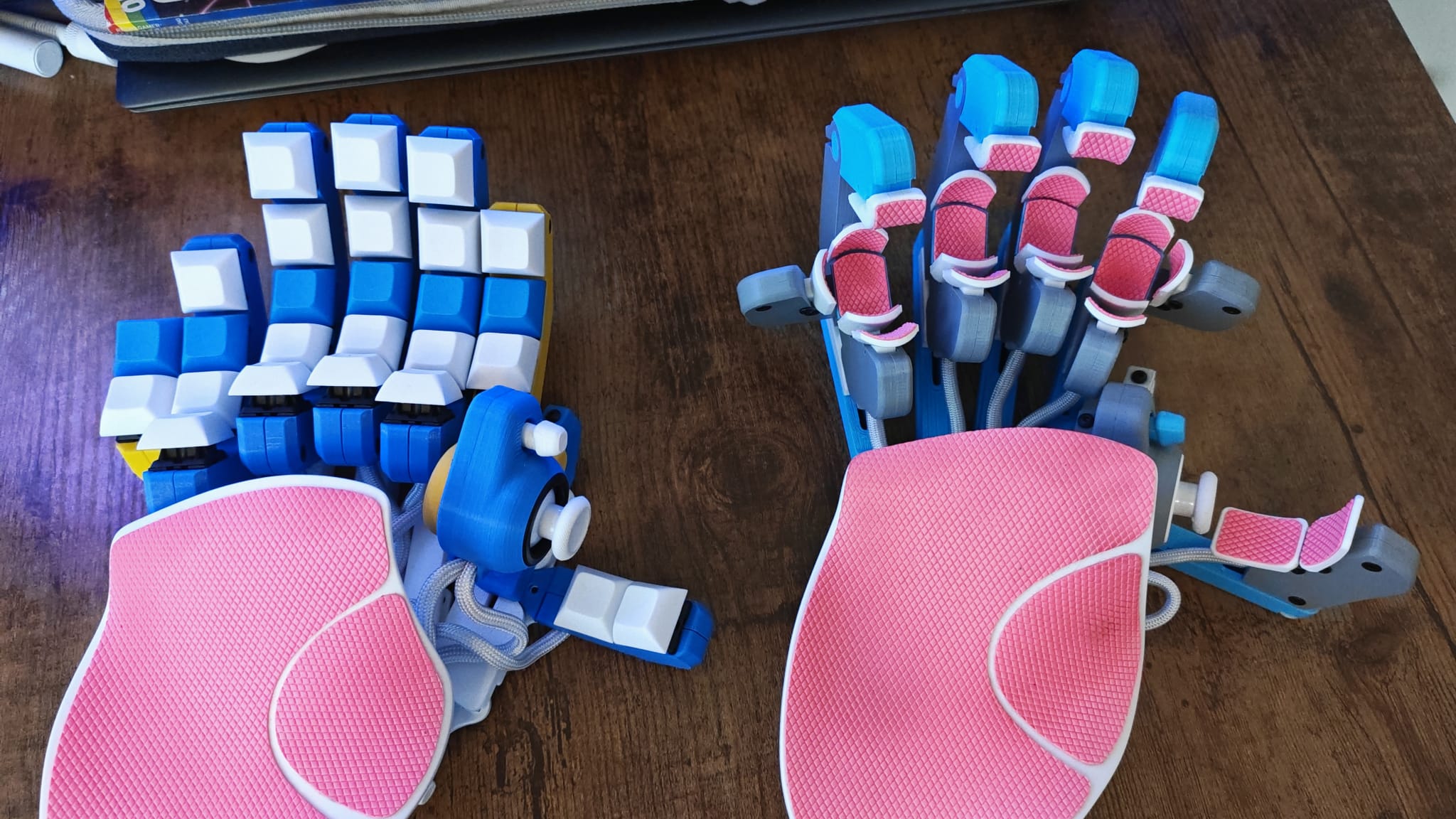
Even with its more conventional approach, I fear that the Azeron Keyzen still takes some explaining. Azeron has made a name for itself by crafting middle-man devices that sit somewhere between the comfort and ergonomics of a controller and the functionality and speed of a keyboard.
Like the Azeron Cyborg II, Keyzen is designed to be used by one hand (left or right) in combination with a mouse. You rest your palm down on it, and each of your fingers is allocated a "tower" or line of keys for you to actuate. Your thumb is allocated a stick, like the ones on a controller, which you can map to the WASD keys, freeing your other fingers up for other in-game actions.
The thumbstick and all 32 mappable keys are your blank canvas to paint your own beautiful control schemes onto. It's up to you to make profiles that suit you and the games you play. Thanks to a handy online community of people who have already been through this often jarring teething process, you can also find profiles others have already made to save some trouble. While I often create new controller profiles for new games I play, a lot of the time, you can absolutely get by with just one profile for most titles.
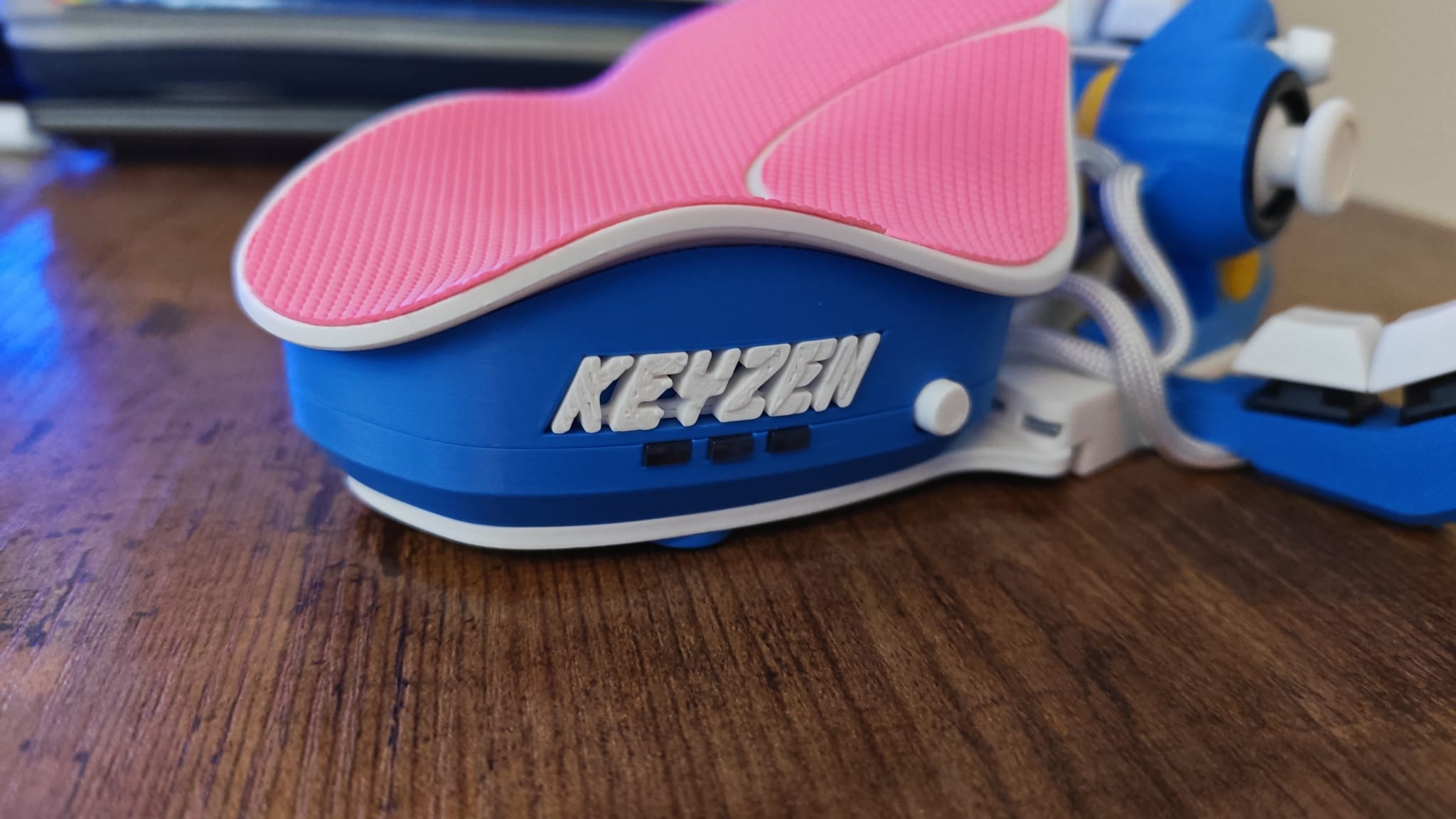
Where Keyzen and the Cyborg II differ is that the "towers" (rows of switches allocated to each finger) on this device only have switches that mainly keep to a horizontal plane - although they curl upwards at the ends, most of the ones you'll use more frequently are laid down flat, like they are on a conventional keyboard. Slight offsets on angles help you to differentiate one from another, as opposed to the sometimes off-putting finger cages of the Cyborg II that wrap around your digits. In converting the Cyborg's design in this way, Azeron has added two extra columns of keys for your pinky and index fingers, which actually results in an increase of two keys over the Cyborg II's 30.
Weekly digests, tales from the communities you love, and more
Keyzen can be adjusted and customized in plenty of different ways, as is one of this brand's USPs. Each keypad is handcrafted from the company's headquarters in Latvia, and although most of its components are 3D printed, it's put together by hand based on your preferences. You can opt for a curved or flat palmrest, you can change the colors and switches used, you can add a custom name plate, or opt for an "elite" metal thumbstick. Although this brand's wares are available at Amazon, the real treat is heading to its bespoke website, where you can build your device from the ground up with a custom designer.
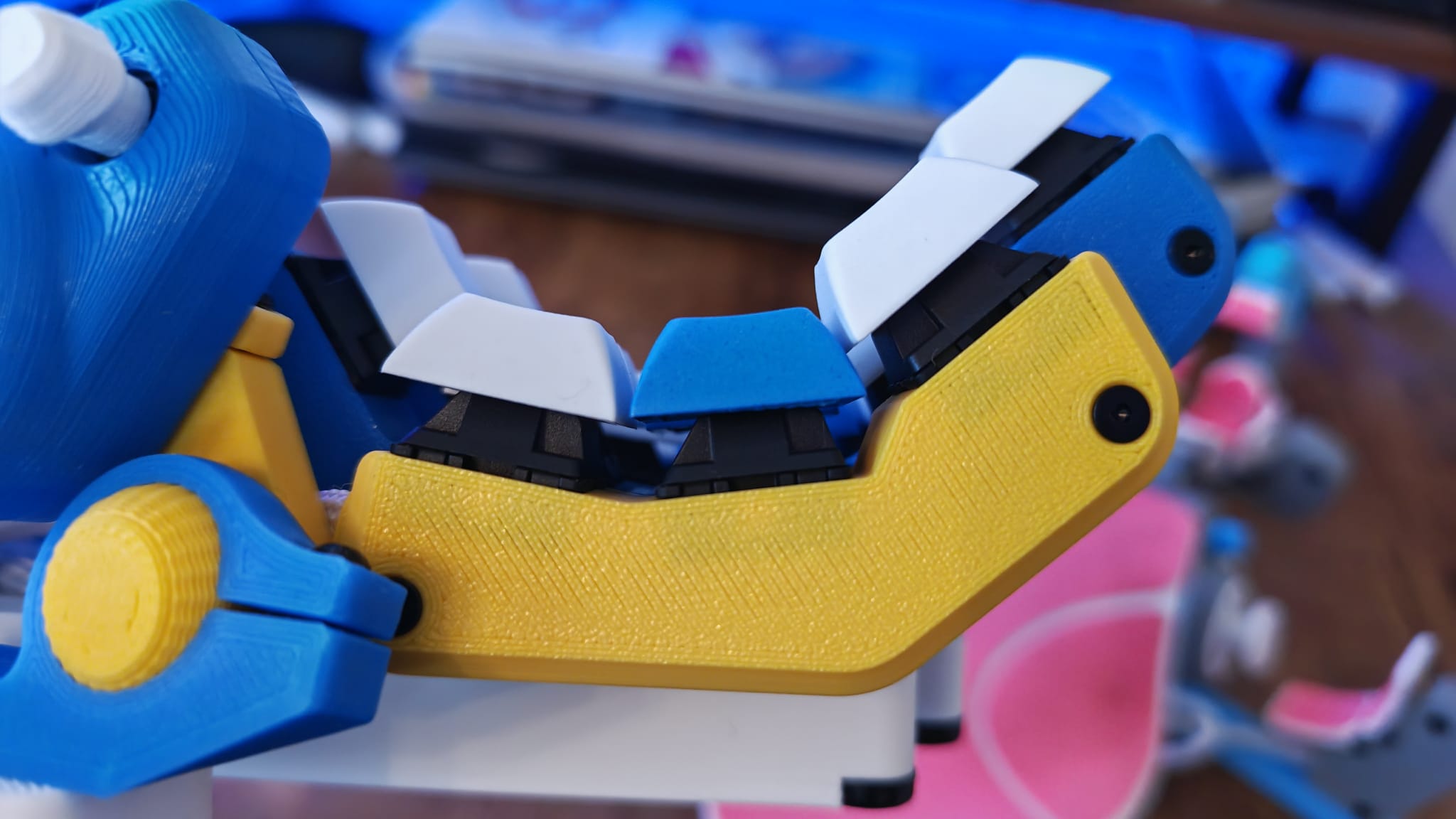
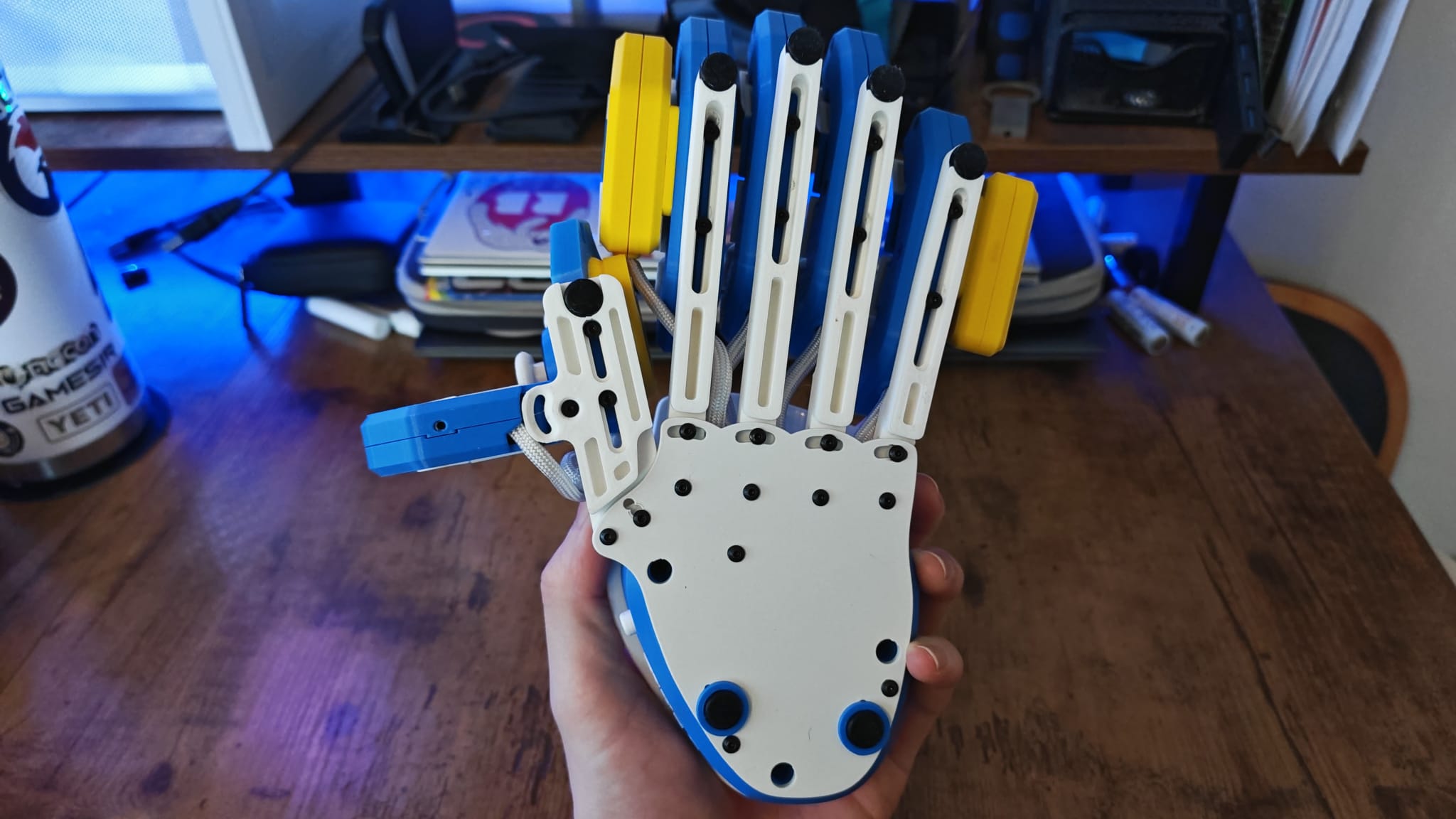
Keyzen is compatible with the angular magnetic stand and grip tape of Cyborg II, although you won't be able to get grip tape for the tops of the keys on the Keyzen, like you can for the Cyborg II.
That shopping experience is really just the beginning too, because once the keypad arrives at your door, you can then change the length of each finger tower so that it's in the right position for your hand. This is one area where I feel as though Keyzen loses out compared to Azeron's other devices, though. There's less adjustability here than I'd like. I'd prefer to be able to change the tilting angles of the keys a little more so that I could more easily distinguish between them. I'd like to be able to recreate the same shape as the Cyborg's towers, but these are mostly all fixed in place.
Something I do have to credit about Keyzen's design is its build quality. One of my few gripes with Azeron's 3D printing is that it doesn't exactly feel premium for its price tag, or even, at times, sturdy enough to last. That really boils down to a feeling - I've never actually run into major fragility issues with this brand's devices besides one screw popping out a few years ago, but with the mouse switches and finger towers on the Cyborgs, I always feel like I need to be careful. With the more substantial keyboard switches aboard Keyzen, that fragile feeling is avoided, and the device has a more premium feeling of build quality as a result.
Features
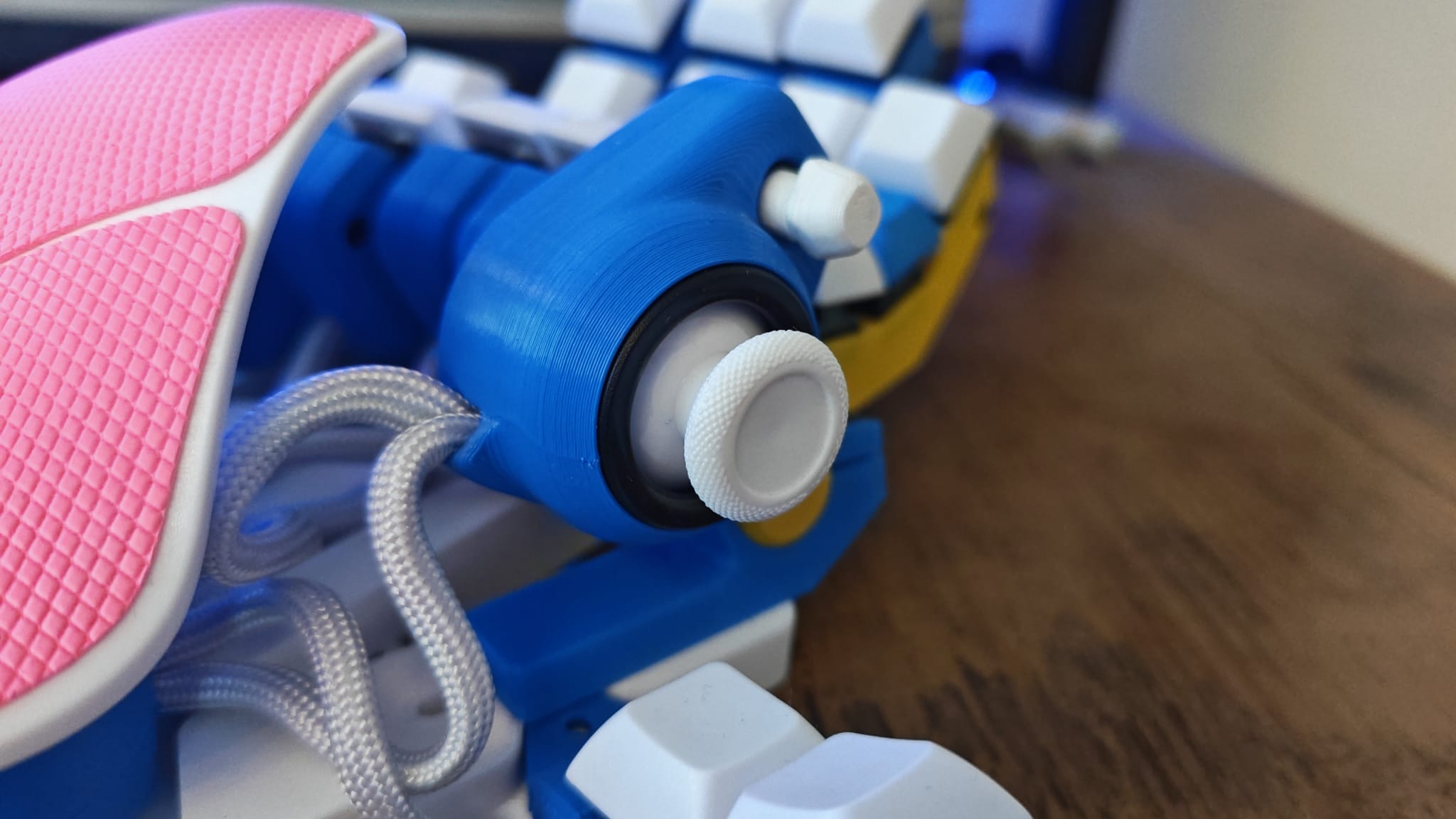
Just like with the Azeron Cyborg II, Keyzen features a Hall effect thumbstick that won't succumb to stick drift, and it can be calibrated through the Azeron software. Switches can be either Cherry Red, Blue, or Brown, but you can only get one type of switch on your keypad. Although the keycaps are removable and supposedly swappable, you won't be able to count this among the best hot-swappable keyboards. Since each Azeron device is handcrafted, I imagine it's a much harder process to mount new switches to a device like this, and you'll be limited by the space you actually have and the angles you'd need to mount them, etc, etc.
I played around 70 hours of Cyberpunk 2077 with this product under my left hand, and every jump, breach initiation, and scan of the environment felt so much more substantial than when I played with a Cyborg.
It's a bit of a shame that these are the only options for key switches, though. As I've just alluded to, I understand the limitations when making a niche product like this, but one of the big appeals of keyboards as a gaming device is that you can truly customize their feel, and in many ways, futureproof yourself when new switches enter vogue. It'd be amazing to see an Azeron keypad with Hall effect switches where you could customize different levels of actuation. It'd be an unholy degree of personalization, but one I think would take the appeal of this product to even greater heights for me. Perhaps this is already an idea the brand is working on for an eventual Keyzen II.
The companion piece to the excellent hardware here is Azeron's software, which allows you to create all of the profiles you want for your pad. You can store up to six profiles on board Keyzen, but the software lets you create limitless numbers, and swapping them on and off the keypad's memory is nice and easy. I even managed to drag a few existing profiles from my Cyborg II onto Keyzen, and with a few minor edits, they were ready to use in under a minute each. For a device as potentially complex as this, Azeron does a remarkable job of making its software streamlined and easy to use.
Performance
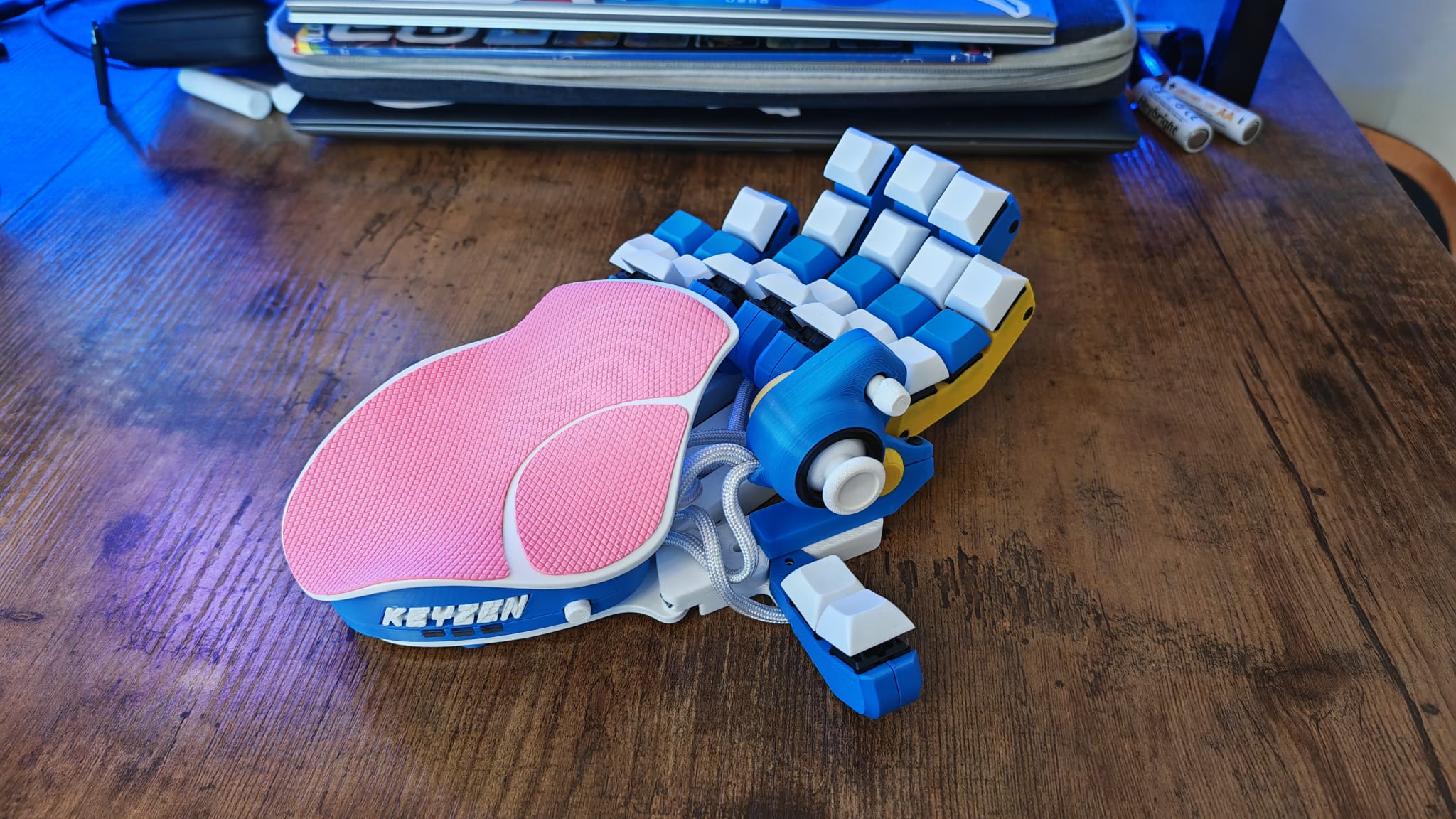
I swapped out my Azeron Cyborg II for the Keyzen for over a month, and all in all, I've put well over 100 hours of gameplay into testing it. That's across mainly first-person games like Cyberpunk 2077, Dying Light: The Beast, Hunt: Showdown, Arena Breakout Infinite, Borderlands 4, and a little bit of Helldivers 2 as well. I didn't test Keyzen in as many genres as I did with the Cyborg II, mainly because reviewing that keypad showed that this line of peripheral is really designed for FPS games first and foremost, with some additional strength in third-person action and MMOs. That might just be my preference though, since Azeron regularly holds livestreams showcasing its devices in games like Hades II. There really is a lot of versatility here, in part due to how creative you can get with its software.
I really don't think Cyborg II lends itself to 2D platformers or fighting games where controllers arguably feel most at home - but with Keyzen providing more of an arrow key setup, I bet you could probably find a way to make these games work if you wanted to.
I chose Cherry Blue switches in my review unit, since I wanted something with a clicky feel to make the crossover from the Cyborg II as natural as possible. Keep in mind that your experience may vary from mine, depending on your switch choice, but for me, keyboard switches added more tactility to the Azeron experience.
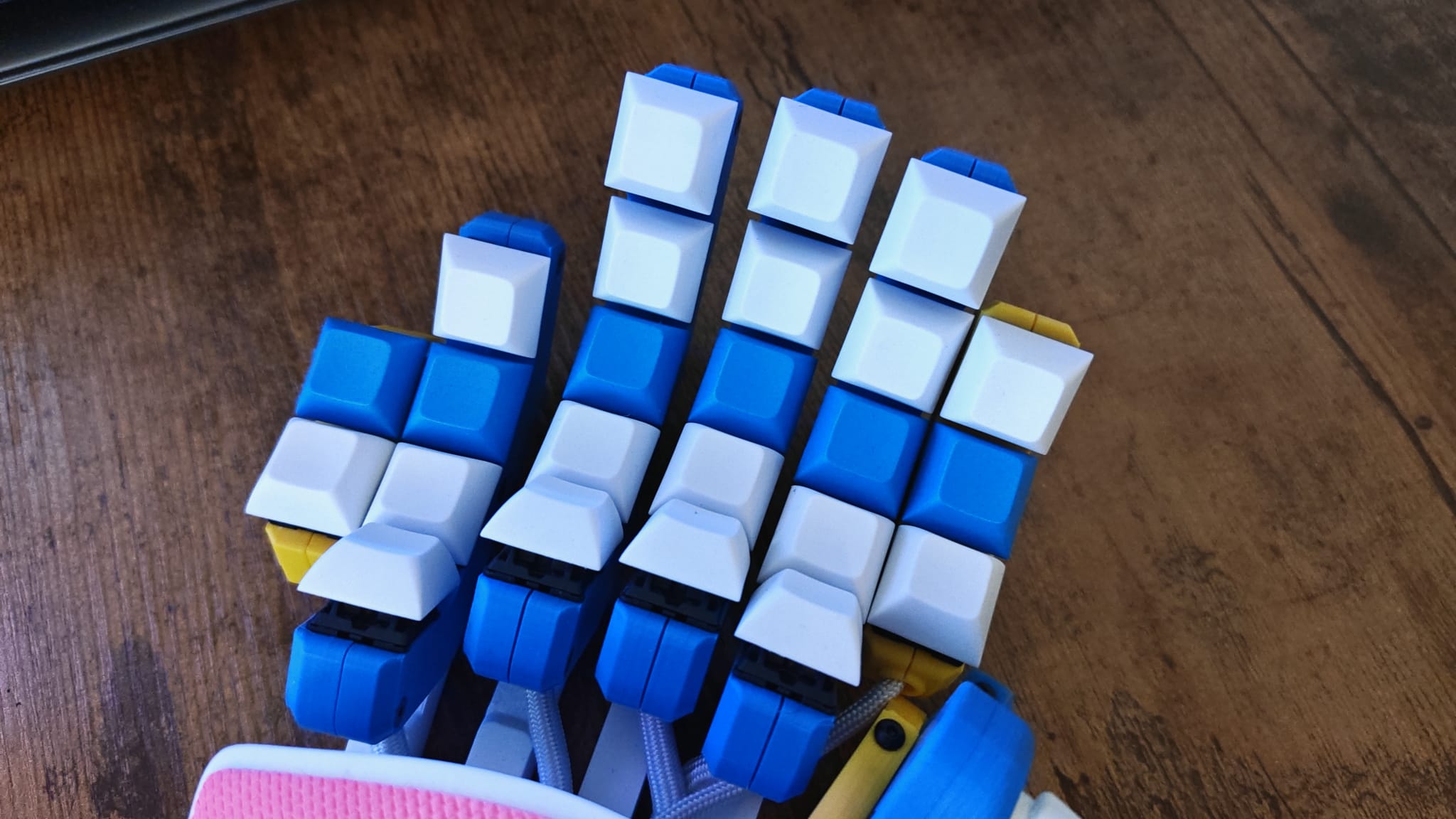
I'm a big lover of the idea of "game feel", but when I use that term off the cuff, a lot of people squint for a second, because although it's a pretty self-explanatory concept, it's a term mainly used by game designers to describe virtual sensation. It's the sum of a lot of things a video game does to make you feel as though your in-game actions have weight and substance. It's a mix of the sound and animation, any effects that are thrown up on screen, or the effort noises your character makes. When I'm reviewing one of the best Xbox Series X controllers, it's fairly easy to assess if they aid or detract from game feel thanks to crunchy feedback rumbling around in your hands.
This is a revolutionary gaming peripheral that will liberate you from dedicated WASD controls, and give you a controller that works for you and your brain.
Once you become fluent in using the Azeron Cyborg, it has decent potential for game feel - not because it has rumble motors or haptic feedback, but because the speed with which you actuate its OMRON keys makes you feel at one with your avatar. On the other hand, compared to all the varying button presses and key sensations from controllers and keyboards, there's a tactility that's slightly lacking from the Cyborg II.
With keyboard switches on the Keyzen, games feel so much weightier. I played around 70 hours of Cyberpunk 2077 with this product under my left hand, and every jump, breach initiation, and scan of the environment felt so much more substantial than when I played with a Cyborg. Especially with the Blue switches I have, the actuation has such a satisfying push-down before the click happens, which adds a feeling of power to melee strikes, jumps, and dashes.
On the flip side, I do feel as though Keyzen misses out on the speed that I love the Cyborg II for. With every switch on that device, a small finger twitch away, not only are the in-game actions quicker to actuate, but they're so much easier to find. One of my biggest issues with Keyzen is that it comes with the same issues a conventional keyboard does for me.
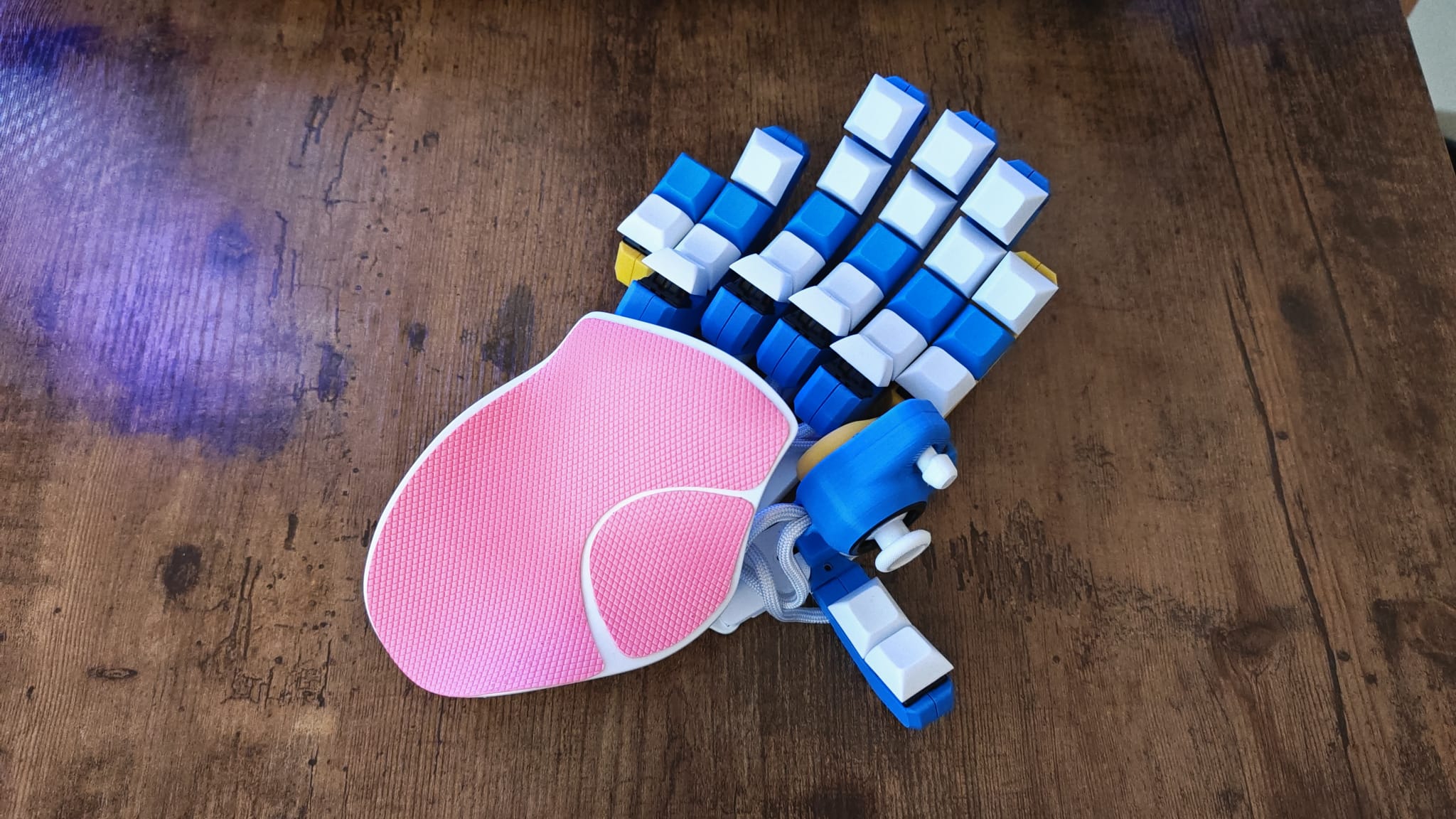
I don't know what it is about my brain that can't differentiate keys on a horizontal board when I'm gaming, but I really struggle. I compare it to when I was forced to take a few piano lessons as a kid, and I couldn't for the life of me distinguish the spaces between each one appropriately. That's one of the biggest reasons I was drawn to the Cyborg keypads to begin with, because it brings all of the keys to your fingers and makes things so much easier to navigate. With Keyzen, even after more than 100 hours played, I still struggle to hit the right ones. This is still a personal preference more than anything else, and I'm sure others who usually play with a keyboard won't have this issue, but there's undoubtedly more margin for error here, especially since there's space between each key that presents more opportunity for fat-fingering, potatoing, or whatever term you use to describe a disastrous mis-press.
For those who do use a keyboard though, or who don't mind all of these typical keyboard hangups, I'll say what I said about the Cyborg II when I reviewed it. This is a revolutionary gaming peripheral that will liberate you from dedicated WASD controls, and give you a controller that works for you and your brain. In that way, this is an unmatched way to play that I really believe points to the future of this hobby.
Should you buy the Azeron Keyzen?
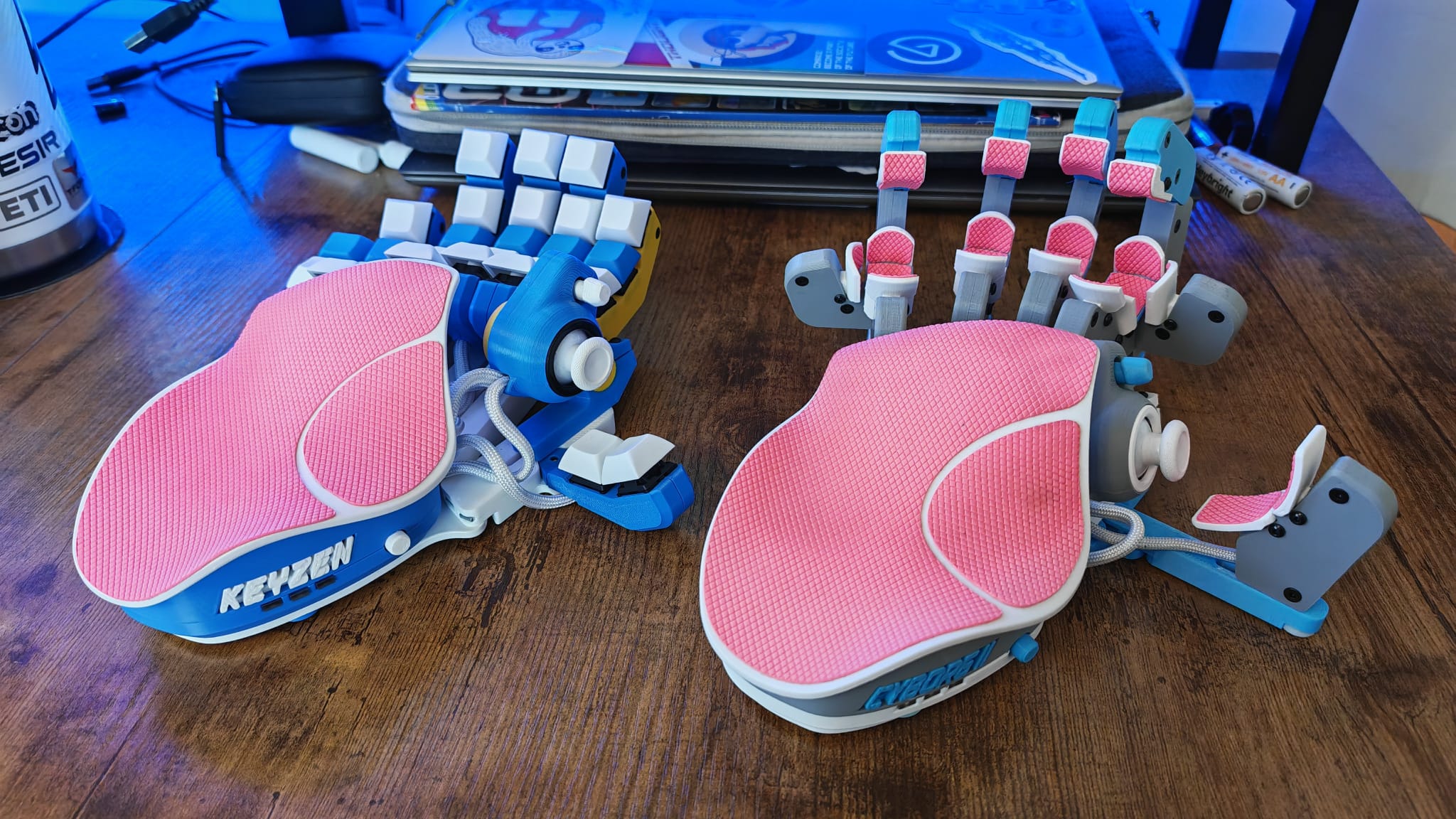
Personally, I think Azeron Cyborg II has the edge over Keyzen, but my arrival at this brand's door may not be for the same reasons as you. If you're more acclimatized to using a keyboard for gaming, this will likely suit you so much more than the clicky mouse switches on the Cyborg. What's more, it'll make for a smoother transition, which can make or break your enjoyment of this device. This is a new way to play, so there's undoubtedly going to be a break-in period for your brain as you re-learn. But if you're already a keyboard enjoyer, that break-in window will be so much shorter for you with Keyzen than it would be with a Cyborg.
If, however, you're like me and you avoid gaming keyboards for a reason, I'd still stick with the Cyborg II. It makes up for its lack of feel with an increase in speed.
Like I stated at the beginning of this review, though, Cyborg and Keyzen feel like siblings, not rivals. There are absolutely small strengths and weaknesses with either, but on the whole, I'd argue that it comes down to your preference. Both offer the same excellent gaming potential that marries keyboards and controllers beautifully.
For me, it's the Cyborg II's speed that comes out on top, but if you'd prefer a bit more feel, the Cherry switches on the Keyzen will help open your mind to a whole new way to play.
How I tested the Azeron Keyzen
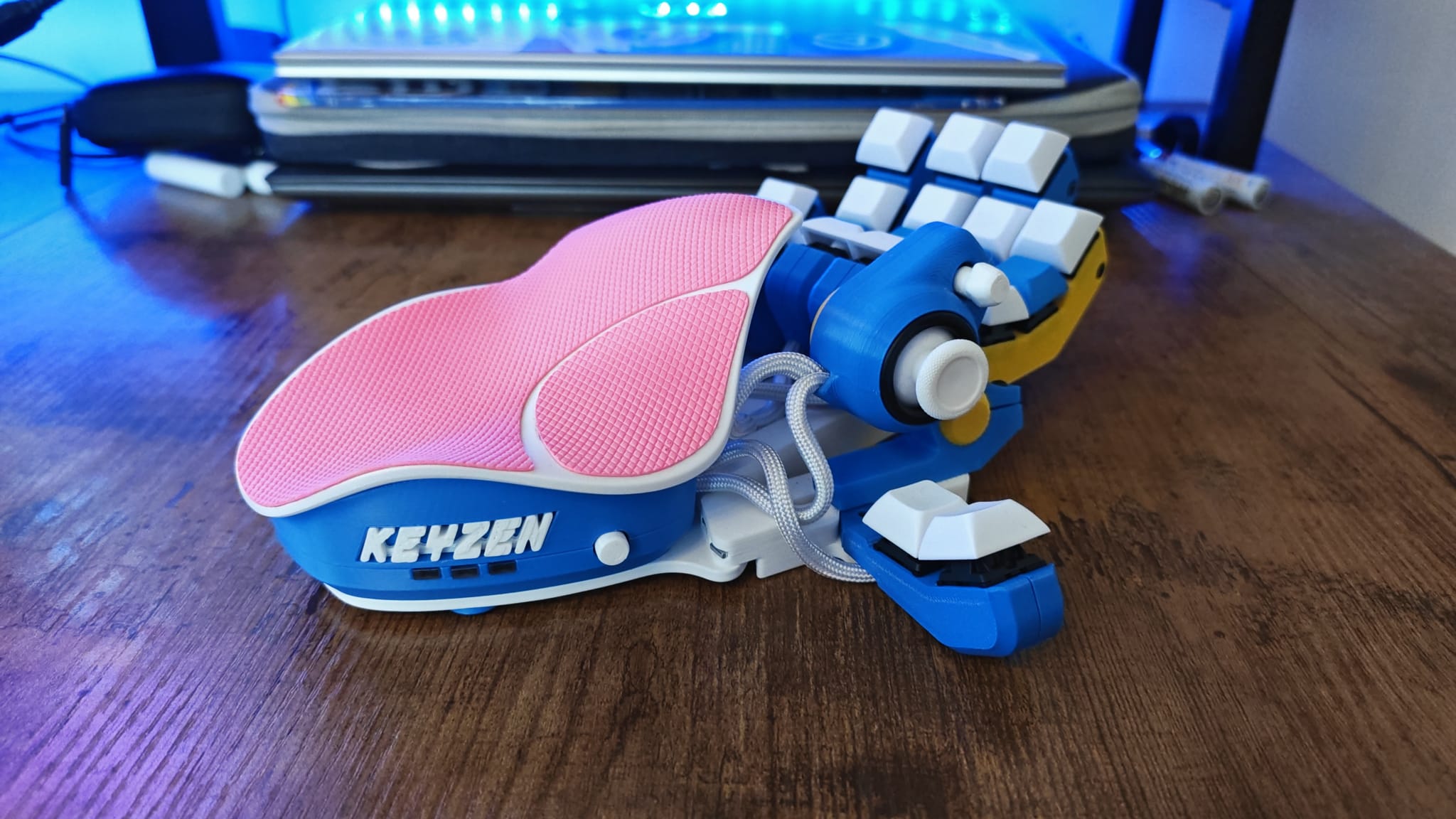
I used the Azeron Keyzen for almost all of my PC gaming for over a month before writing this review. All in all, I put more than 100 hours into testing it, mainly in first-person games.
I compared my experience very closely to my time with previous Azeron products, and even designed my review unit using the brand's custom builder to get a better sense of how the customer experience can be.
For more on how we test controllers, check out the GamesRadar+ Hardware Policy.
Looking for more conventional controllers? Check out the best PS5 controllers, the best PS4 controllers, and the best Xbox One controllers.
One of my earliest memories is playing SuperMario64 and wondering why the controller I held had three grips, but I only had two hands. Ever since I've been in love with video games and their technology. After graduating from Edinburgh Napier University with a degree in Journalism, I contributed to the Scottish Games Network and completed an Editorial Internship at Expert Reviews. Over the last decade, I’ve been managing my own YouTube channel about my love of games too. These days, I'm one of the resident hardware nerds at GamesRadar+, and I take the lead on our coverage of gaming PCs, VR, controllers, gaming chairs, and content creation gear. Now, I better stop myself here before I get talking about my favourite games like HUNT: Showdown, Dishonored, and Towerfall Ascension.
You must confirm your public display name before commenting
Please logout and then login again, you will then be prompted to enter your display name.


